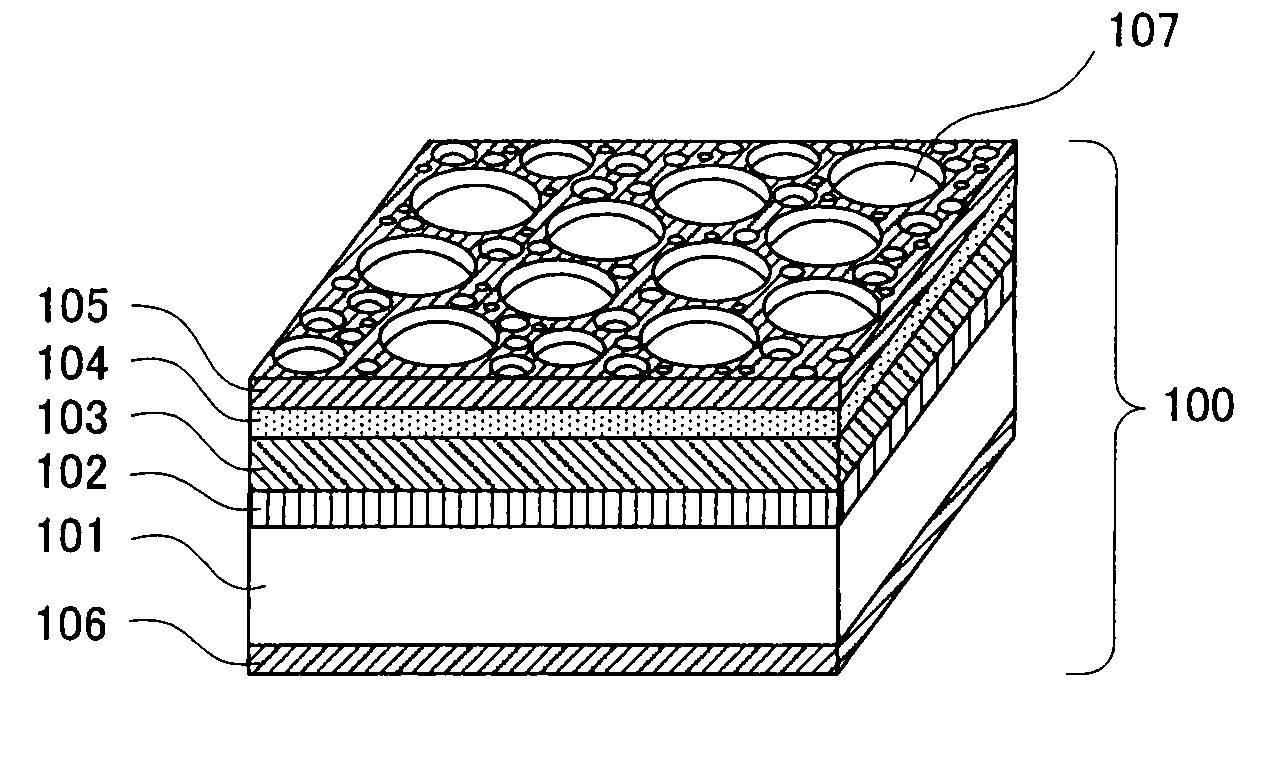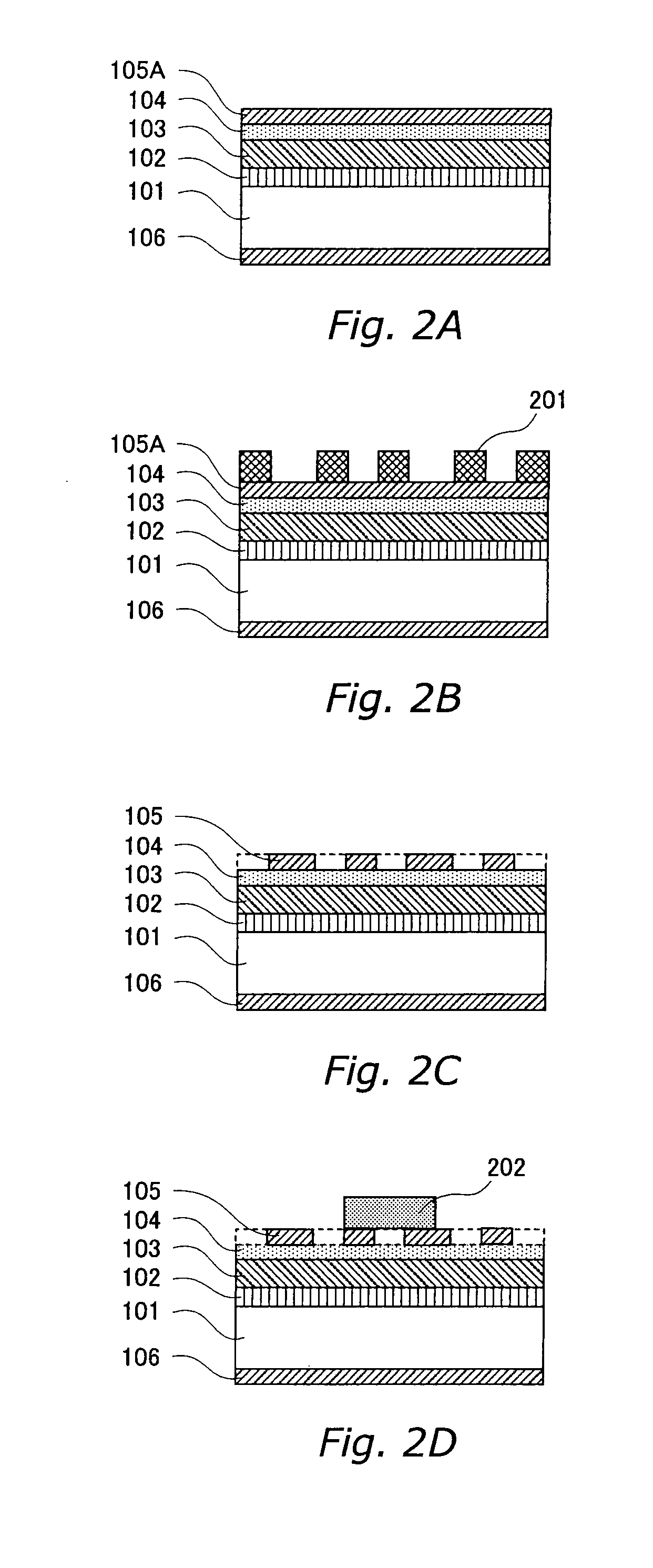Semiconductor light-emitting device and process for production thereof
- Summary
- Abstract
- Description
- Claims
- Application Information
AI Technical Summary
Benefits of technology
Problems solved by technology
Method used
Image
Examples
example 1
[0126]In accordance with the aforementioned process, a semiconductor light-emitting device was produced. In Example 1, the device was made 300 μm square in size, which is the same as a conventional device, so that the device comprising a metal electrode provided with openings could be evaluated in properties comparatively with a conventional device.
[0127]As shown in FIG. 2A, a hetero structure 102 including an n-type InAlP clad layer, an InGaP active layer and a p-type InAlP clad layer was formed on an n-GaAs substrate 101. Further, a current-spreading layer 103 of four-elemental p-type InGaAlP was epitaxially grown thereon. On the current-spreading layer thus formed, a p-type GaAs contact layer 104 (0.1 μm) was formed so as to ensure ohmic contact. On the opposite side of the substrate, an n-type counter electrode 106 was provided.
[0128]Subsequently, on the p-type GaAs contact layer, a metal thin layer 105A of Au (10 nm) / Au—Zn (3%) (30 nm) was formed by vapor deposition. The formed...
example 2
[0134]A semiconductor light-emitting device having the structure of n-GaAs / n-InAlP / InGaP / p-InAlP / p-InGaAlP / p-GaAs, which was similar to the device of Example 1, was prepared. The procedure of Example 1 was repeated to form a metal electrode layer provided with openings.
[0135]On the p-type GaAs layer, an Au (10 nm) / Au—Zn (3%) (30 nm) layer was formed by vapor deposition and thereafter annealed at 450° C. for 30 minutes in nitrogen gas atmosphere.
[0136]After that, the Au / Au—Zn layer was coated with an electron beam resist in the same manner as in Example 1, and treated by use of a pattern generator to form a hole pattern in which the diameter and interval of openings were 100 nm and 200 nm, respectively.
[0137]Subsequently, the Au / Au—Zn layer was etched by means of an ion-milling machine in the same manner as in Example 1, to form a metal electrode layer provided with openings. After the etching procedure, the resist was removed by oxygen ashing. Finally, a pad electrode was formed to ...
example 3
[0140]A semiconductor light-emitting device having the structure of n-GaAs / n-InAlP / InGaP / p-InAlP / p-InGaAlP / p-GaAs, which was similar to the device of Example 1, was prepared. On the p-type GaAs layer 104, a metal thin layer 105A of Au (10 nm) / Au—Zn (3%) (30 nm) was formed by vapor deposition and thereafter annealed at 450° C. for 30 minutes in nitrogen gas atmosphere (FIG. 5A).
[0141]After that, the Au / Au—Zn layer was coated with an i-ray resist (THMR-iP3650 [trademark], manufactured by TOKYO OHKA KOGYO CO., LTD.) to form a resist layer of 1 μm thickness. The resist layer was treated by use of an i-ray stepper exposure system, to form a hole pattern in which the diameter and interval of openings were 500 nm and 1 μm, respectively (FIG. 5B).
[0142]Subsequently, the Au / Au—Zn layer was etched by means of an ion-milling machine in the same manner as in Example 1, to form a metal electrode layer 105 provided with openings. After the etching procedure, the i-ray resist was removed by oxygen...
PUM
 Login to View More
Login to View More Abstract
Description
Claims
Application Information
 Login to View More
Login to View More - R&D
- Intellectual Property
- Life Sciences
- Materials
- Tech Scout
- Unparalleled Data Quality
- Higher Quality Content
- 60% Fewer Hallucinations
Browse by: Latest US Patents, China's latest patents, Technical Efficacy Thesaurus, Application Domain, Technology Topic, Popular Technical Reports.
© 2025 PatSnap. All rights reserved.Legal|Privacy policy|Modern Slavery Act Transparency Statement|Sitemap|About US| Contact US: help@patsnap.com



